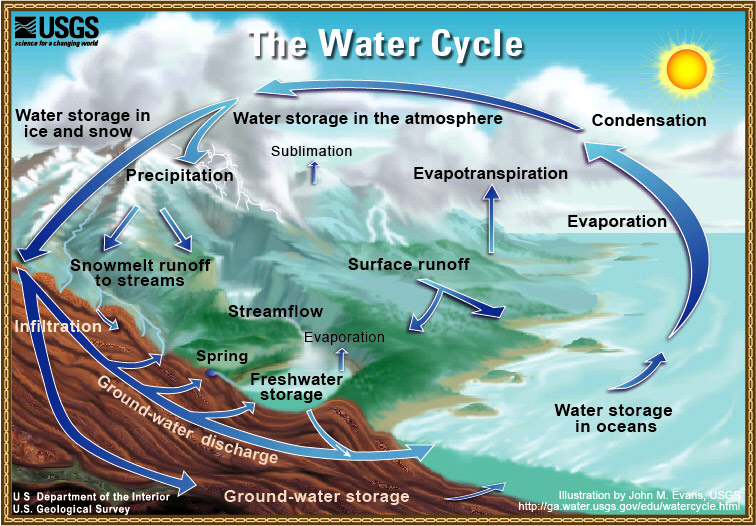
INTRODUCTION TO THE ATMOSPHERE
CHAPTER 1 and CHAPTER 2 - TEST 1 - SEPTEMBER 15TH 2025
WATCH VIDEO ----CHAPTER 1
Geosphere - Solid part of the earth. Geology
Hydrosphere - Study of all the water on the earth. 97% of the water is in the oceans.. Oceanography
Atmosphere - Study of all the air around the Earth. Meteorology. Remember this course is introduction to Meteorology.
Biosphere - Study of life forms on the Earth itself. Biology
A system is a group of interacting parts that form a complex whole.
Closed systems are those in which energy moves freely in and out, but matter does not enter or leave the system. In an open system, both energy and matter flow into and out of the system.
The two sources of energy that power the Earth system are
(1) the Sun, which drives the external processes that occur in the atmosphere,
hydrosphere, and at Earth's surface, and
.
(2) heat from Earth's interior that powers the internal processes that produce
volcanoes, earthquakes, and mountains.
The hydrologic cycle is just one of earth's many Subsystems. The continuous movemenet of water from the Oceans to the Atmpshere (by evaporation) from the atmpshere to land (by condensation and precipiation) and from the land back to sea(via stream flow).
The Atmosphere has a mixture of gases and they vary from time to time and place to place. The most abundant gas is Nitrogen N2 (78%). The second is Oxygen 02 (21%). these two gasses make up 99% of the Earth's Atmosphere. Other components include Carbon Dioxide, Water vapor and Dust particles. Carbon Dioxide makes up only .037%, which is a very small amount but Carbon Dioxide is a very good absorber of energy.
The variable components of air include water vapor, dust particles, and ozone. Like carbon dioxide, water vapor can absorb heat given off by Earth as well as some solar energy. When water vapor changes from one state to another, it absorbs or releases heat. In the atmosphere, water vapor transports this latent ("hidden") heat from one region to another, and it is the energy source that helps drive many storms. Water Vapor by volume is up to 4 percent.
Aerosols (tiny solid and liquid particles) are meteorologically important because these often invisible particles act as surfaces on which water can condense and are also absorbers and reflectors of incoming solar radiation.
Ozone, a form of oxygen that combines three oxygen atoms into each molecule (O3), is an important gas concentrated in the 10 to 50 kilometer height in the atmosphere that absorbs the potentially harmful ultraviolet (UV) radiation from the Sun. Located in the Stratosphere.
For Long Island:
Islip
https://www.weather.gov/wrh/Climate?wfo=okx
Brookhaven National Lab
https://www.bnl.gov/weather/
Example.
Islip Mac Arthur Airport
January: Average High Temperature 39 Low: 24, August 31: Average High 79 Low
62 <<<--- Example of climate.
Records date back to 1964
Monthly Almanacs
Daily climatological data can be analyzed to produce averages and records. This information is included in our monthly almanacs.
The almanacs also contain times of sunrise and sunset times and daily records of precipitation and snowfall. This is an example of Climate for an area on a given date.
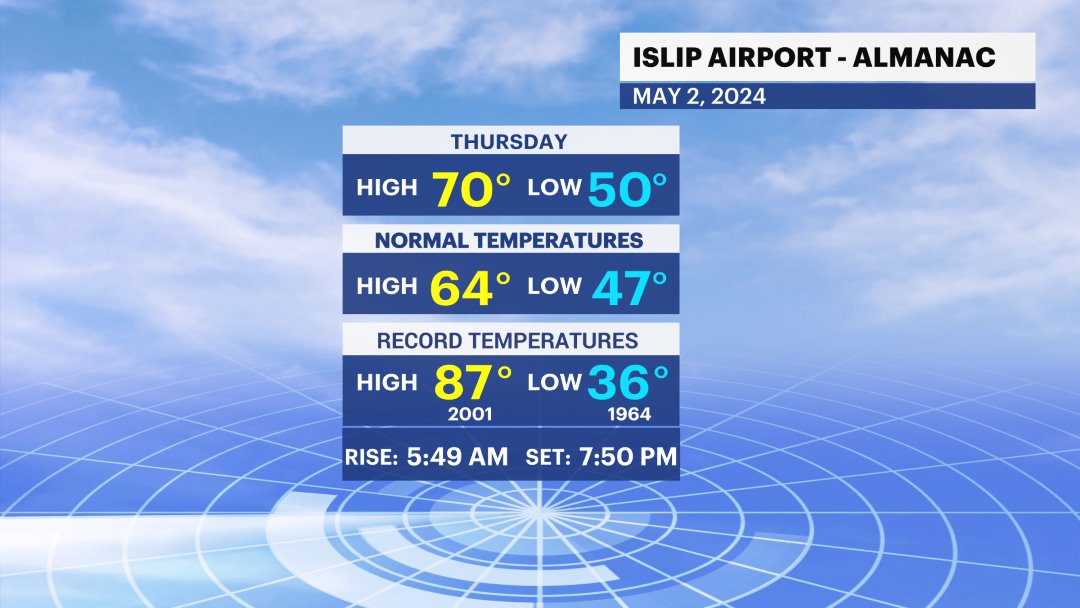
Brookhaven National Lab (BNL) January: Average High Temperature 37 Low: 23, August 31: Average High 78 Low 60
Extreme: High: 100.5 =101 July 21 1991 & July 22, 1957
Low: -23.0 F January 22, 1961
Records date back to 1947
Climate - is an aggregate of weather conditions, the sum of all statistical
weather information that helps describe a place or region.
Weather (WX) is defined as the day to day state of the Atmosphere at a given
time and place. Pertains to short term changes. (Present to 10days).
Heat - Heat supplies the energy to drive the atmosphere
Moisture -- Supplies water for clouds and precipitation and also supplies energy by latent heat of vaporization
Air Pressure - Differences in air pressure causes the WIND.

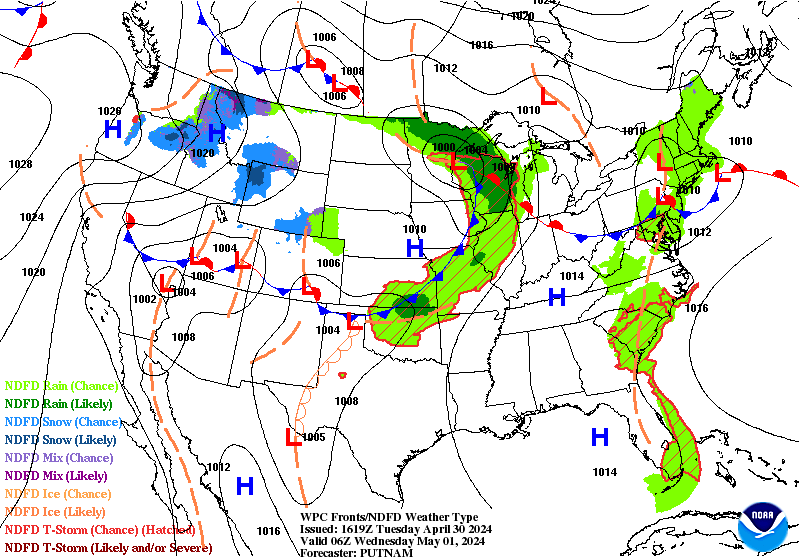
Balloons play a significant role in the systematic investigation of the atmosphere by carrying radiosondes (lightweight packages of instruments that send back data on temperature, pressure, and relative humidity) into the lower atmosphere. Rockets, airplanes, satellites, and weather radar are also among the methods used to study the atmosphere.
More on balloon and Radiosondes.
Levels in the Atmosphere: See figure 1.20 page 18.
Thermal Structure of the Atmosphere Pages 16 to 20 - study this!!!!
Using temperature as the basis, the atmosphere is divided into four major layers, but pauses are also layers.
1)Troposphere
2)Stratosphere
3)Mesosphere
4)Thermosphere
Each layer is divided by a pause. The Ionosphere is inside the Thermosphere.
The temperature decrease in the troposphere, the bottom layer in which we
live, is called the environmental lapse rate. Its average value is 6.5°C
per kilometer,(3.5/3.6 F per 1000 feet) a figure known as the normal lapse rate.
The environmental lapse rate is not a constant and must be regularly
measured using radiosondes. See current Sounding/Temperature profile of Atmosphere
Examples of Soundings - https://www.weather.gov/jetstream/skewt_samples - https://www.weather.gov/jetstream/skewtplots
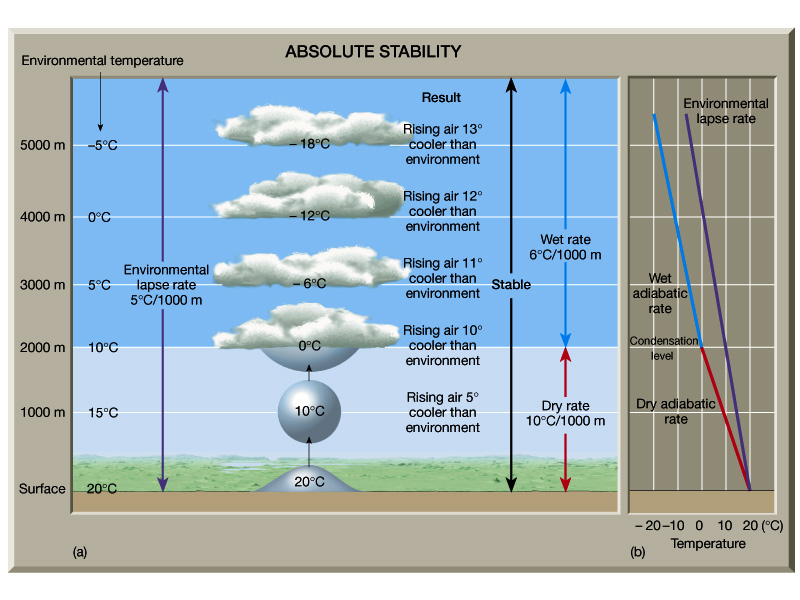 |
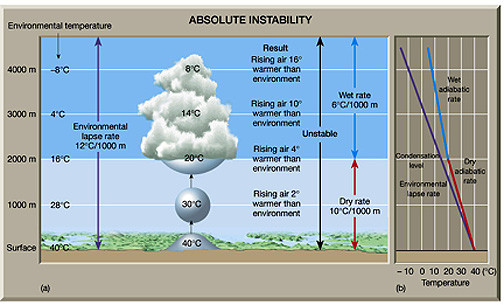 |
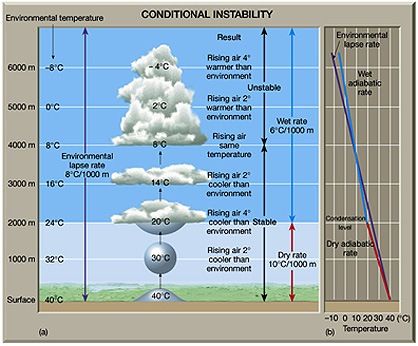 |
A temperature inversion, where temperatures increase with height, is sometimes observed in shallow layers in the troposphere. Most of the time temperatures decrease with hieght. The greater the temperature drop with height the more unstable the atmposphere. The thickness of the troposphere is generally greater in the tropics than in polar regions. Essentially all important weather phenomena occur in the troposphere. The Troposphere is also known as the "Weather Sphere"
Beyond the troposphere lies the Stratosphere; the boundary between the troposphere and stratosphere is known as the tropopause. In the stratosphere, the temperature at first remains constant to a height of about 20 kilometers (12 miles) before it begins a sharp increase due to the absorption of ultraviolet radiation from the Sun by ozone. The temperatures continue to increase until the stratopause is encountered at a height of about 50 kilometers (30 miles).
In the Mesosphere, the third layer, temperatures again decrease with
height until the mesopause, some 80 kilometers (50 miles) above the surface.
Mesopause is the coldest layer in the atmosphere.
The fourth layer, the Thermosphere, with no well-defined upper limit,
consists of extremely rarefied air. Temperatures here increase with an increase
in altitude and this is the warmest layer in the atmosphere, and can reach temperatures
1000C (1800F).
The Ionosphere
Occurring in the altitude range between 80 and 400 kilometers (50-250 miles)
is an electrically charged layer known as the ionosphere. Here, molecules of
nitrogen and atoms of oxygen are readily ionized as they absorb high-energy,
shortwave solar energy. Three layers of varying ion density (from top to bottom,
the D, E, and F layers, respectively) make up the ionosphere.
The ionosphere lies from about 80-400 km in height and is electrically charged as short wave solar radiation ionizes the gas molecules. The electrical structure of the atmosphere is not uniform and is arranged into three layers, D, E, and F. Since the production of charged particles requires solar radiation, the thickness of each layer, particularly the D and E layers, changes from night to day. The layers weaken and disappear at night and reappear during the day. The F layer is present during both day and night. This change in height of the various electrically charged layers doesn't effect the weather, but does effect radio signals.
The auroras also take place in the ionosphere since this is the electrically charged layer. The aurora borealis (northern lights) and aurora australis (southern lights) is closely correlated to solar flare activity.
Auroras (the aurora borealis, northern lights, and its Southern Hemisphere
counterpart the aurora australis, southern lights) occur within the ionosphere.
Auroras form as clouds of protons and electrons ejected from the Sun during
solar-flare activity enter the atmosphere near Earth's magnetic poles and energize
the atoms of oxygen and molecules of nitrogen, causing them to emit light-the
glow of the auroras. AURORA
PAGE
http://en.wikipedia.org/wiki/Aurora_(astronomy)
 |
 |
 |
Check out Spaceweather.com
FOR TEST---CHAPTER 1 and CHAPTER 2 - TEST 1 - SEPTEMBER 15TH 2025
Don't forget you MUST read the chapters in the Book!!!!
Know levels of the atmosphere. What is important about each level, what makes one different from the next. Air, Temperature, Gases and Location.
Climate and Weather - They are different. Why and How. Almanac gives an idea of the climate of the Area.
Seasons - Why do we have sesasons. Where do they sun's rays hit the Earth. How much radiation do we receive? What are the dates of the seasons. How much daylight
does Long Island see during the different
seasons.
Three heat transfers. Page 37.
Why is the sunsets red and sky blue?
Albedo
Wavelengths
Below is a recap of Chapter 1 and Chapter 2.
Some of the main topics on Test 1 --email me if you have any questions - richard.hoffman@farmingdale.edu
TEST 1 - Chapter 1 / Chapter 2 TEST 1 - SEPTEMBER 15TH 2025